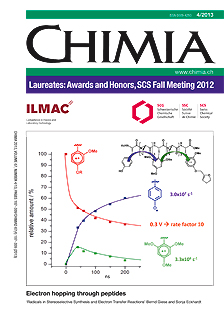Surface Modification of Biomaterials for Conjugation with Human Fetal Osteoblasts
DOI:
https://doi.org/10.2533/chimia.2013.213Keywords:
Cell adhesions, Copper-free click reaction, Functionalized biomaterials, Human fetal osteoblastsAbstract
Surface functionalization of hydroxyapatite (HA) and ?-tricalcium phosphate (TCP) bioceramics with chemical ligands containing a pyrrogallol moiety was developed to improve the adhesion of bone cell precursors to the biomaterials. Fast and biocompatible copper-free click reaction with azido-modified human fetal osteoblasts resulted in improved cell binding to both HA and TCP bioceramics, opening the way for using this methodology in the preparation of cell-engineered bone implants.Downloads
Published
2013-04-24
Issue
Section
Scientific Articles
License
Copyright (c) 2013 Swiss Chemical Society

This work is licensed under a Creative Commons Attribution-NonCommercial 4.0 International License.
How to Cite
[1]
F. Borcard, P. Kong, C. Journot, D. Staedler, P. N. Sturzenegger, F. K. Juillerat, U. T. Gonzenbach, L. Juillerat-Jeanneret, S. Gerber-Lemaire, Chimia 2013, 67, 213, DOI: 10.2533/chimia.2013.213.







